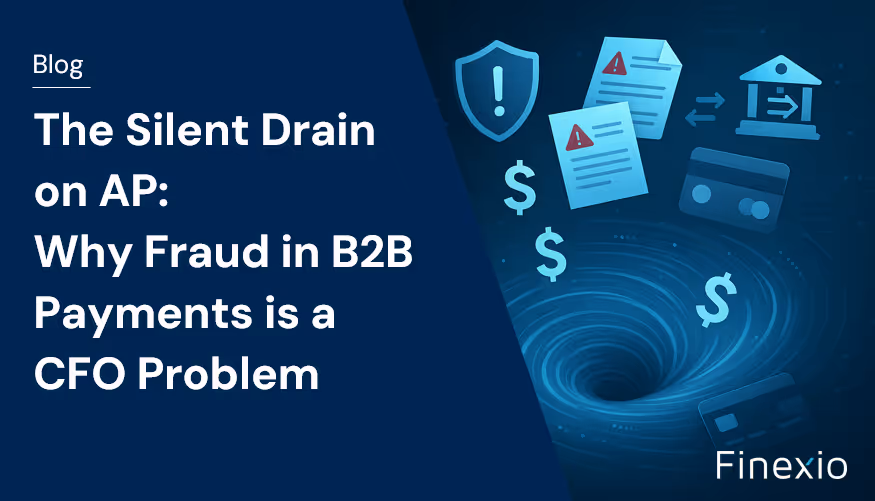The Silent Drain on AP: Why Fraud in B2B Payments Is a CFO Problem


How AI-powered fraud threatens your bottom line and what strategic CFOs are doing about it
Picture this: Your AP team processes what appears to be a routine invoice from a trusted supplier. The documentation looks perfect, the amounts seem reasonable, and the approval workflow proceeds normally. Three weeks later, you discover that $247,000 has been transferred to a fraudulent account controlled by cybercriminals who used AI to create hyper-realistic forgeries of your supplier's invoices and supporting documents.
This isn't a hypothetical scenario—it's the new reality facing CFOs across industries as artificial intelligence democratizes sophisticated fraud techniques while simultaneously creating unprecedented opportunities for protection.
The Perfect Storm: When Digital Transformation Meets AI-Powered Fraud
CFOs today find themselves navigating a paradox. The same digital transformation initiatives driving operational efficiency and competitive advantage have also created new vulnerabilities that sophisticated fraudsters are eager to exploit.
Recent data from the Association for Financial Professionals paints a sobering picture:
79% of organizations reported attempted or actual fraud targeting their payment systems in 2024, with Business Email Compromise (BEC) remaining the top attack vector, cited by 63% of respondents. The financial impact is staggering—global BEC losses surpassed $6.7 billion in 2024, with individual incidents averaging over $137,000 per occurrence.
But here's what makes this particularly challenging for CFOs: the fraud landscape is evolving faster than most organizations can adapt. Where traditional fraud relied on crude social engineering and obvious forgeries, AI-powered attacks now feature:
• Hyper-realistic document generation that's virtually indistinguishable from legitimate invoices
• Synthetic supplier identities complete with convincing websites and financial histories
• Personalized social engineering campaigns tailored to specific individuals and organizations
• Voice and video deepfakes that can convincingly impersonate executives and trusted partners
As Mastercard CFO Sachin Mehra recently observed, "Technology works both ways. Right now, if it helps us, it also helps the people who want to do bad acts and in this case, people who want to do fraudulent activity, cyber crime, or whatever the case might be."
Why This Is No Longer Just an IT Problem
Traditionally, fraud prevention has been relegated to IT security teams. But the evolution of B2B payment fraud has fundamentally shifted this dynamic, making it a strategic financial risk that demands CFO leadership.
The Financial Governance Imperative
Modern payment fraud directly impacts the core responsibilities that keep CFOs awake at night:
• Cash Flow Management: Fraudulent payments create immediate liquidity impacts and complicate working capital optimization strategies.
• Financial Reporting Integrity: Sophisticated fraud can compromise financial statement accuracy and trigger audit complications that extend far beyond the initial loss.
• Stakeholder Confidence: Repeated fraud incidents erode trust with investors, board members, and business partners who expect demonstrable risk management leadership.
• Regulatory Compliance: Financial executives bear ultimate responsibility for internal controls under regulations like Sarbanes-Oxley, making fraud prevention a compliance imperative.
The Cross-Functional Challenge
Effective fraud prevention requires orchestration across multiple business functions—procurement, legal, compliance, and operations—coordination that naturally falls under CFO purview. This isn't about implementing another software tool; it's about transforming how your organization approaches risk management across the entire payment ecosystem.
Consider the cascading effects of a single successful fraud incident: immediate financial losses, emergency process changes, supplier relationship damage, increased audit scrutiny, and potential regulatory action. The total impact often extends far beyond the initial fraud loss when all factors are considered.
The Economics of AI-Powered Fraud: Understanding What You're Up Against
To build an effective defense strategy, CFOs must understand how AI has fundamentally altered the economics of financial fraud:
Democratized Sophistication
What once required significant resources and specialized knowledge is now accessible to motivated criminals through readily available AI tools, enabling automated attacks at unprecedented scale with continuous adaptation based on defensive responses.
Enhanced Success Rates
AI-powered attacks show dramatically higher success rates than traditional methods:
• 40% of BEC emails are now AI-generated, making them increasingly difficult to detect
• Vendor impersonation remains a top threat, as fraudsters leverage AI to create convincing supplier profiles
• Average business interruption costs for SMEs hit by BEC now reach $487,000, demonstrating the expanding impact beyond direct losses
Multi-Vector Coordination
Modern fraud campaigns deploy sophisticated, coordinated approaches:
• Initial email reconnaissance followed by AI-generated voice calls for "verification"
• Deep fake video conferences with "suppliers" or "executives"
• Comprehensive documentation packages that create complete false narratives
As fraud prevention expert Kathy Stokes from AARP warns, "Fraud is at a crisis level in this country. Perpetrators have the money, they have the time, and they've got the playbook to get you into that heightened emotional state. It's us against them."
The Strategic CFO Response: From Reactive to Predictive
Leading CFOs are recognizing that traditional fraud prevention approaches—static rules, manual reviews, and post-incident audits—are inadequate against AI-powered threats. Instead, they're embracing a new paradigm: Predictive fraud prevention that leverages AI to fight AI.
The Technology Transformation
Advanced fraud prevention platforms now employ multiple AI technologies working in concert:
• Machine Learning Models: Combining supervised and unsupervised learning approaches to improve fraud detection capabilities while reducing false positives.
• Natural Language Processing: Analyzing invoice content, email communications, and supporting documents for subtle inconsistencies that indicate AI generation or manipulation.
• Behavioral Analytics: Monitoring user behavior patterns to detect account compromises or suspicious activities before they result in fraudulent transactions.
• Real-Time Risk Scoring: Assessing every transaction against hundreds of factors to enable dynamic decision-making and adaptive authentication.
The Operational Reality
Organizations implementing advanced fraud prevention systems report significant improvements in detection capabilities, reduced manual processing requirements, and enhanced supplier relationships through more efficient and secure payment processes.
Building Your Defense Strategy: A CFO's Action Plan
Ready to transform your fraud prevention capabilities? Here's a strategic roadmap for CFOs:
Phase 1: Assessment and Foundation (Months 1-3)
- Conduct comprehensive risk assessment of current AP processes and vulnerabilities
- Quantify fraud exposure and establish baseline metrics
- Secure executive alignment and budget allocation for fraud prevention investments
- Begin deployment of basic AI-powered fraud detection capabilities
Phase 2: Advanced Implementation (Months 4-8)
- Deploy sophisticated document analysis and vendor verification systems
- Implement behavioral analytics and real-time risk scoring
- Integrate with existing ERP and financial systems for seamless workflow
- Establish advanced monitoring and reporting capabilities
Phase 3: Optimization and Strategic Value Creation (Months 9-12)
- Fine-tune AI models based on operational experience and performance data
- Implement predictive analytics for proactive threat identification
- Develop executive-level reporting and strategic decision support capabilities
- Build organizational capabilities for continuous improvement and adaptation
Critical Success Factors
• Executive Sponsorship: Maintain strong leadership commitment throughout implementation with regular progress updates and success communication.
• Cross-Functional Integration: Engage stakeholders from procurement, legal, IT, and operations to ensure coordinated execution.
• Performance Measurement: Establish comprehensive metrics that track both fraud prevention effectiveness and operational efficiency gains.
• Continuous Evolution: Build capabilities for ongoing adaptation as threats evolve and new technologies emerge.
The Future-Ready CFO Advantage
CFOs who proactively address AI-powered fraud threats position their organizations for significant strategic advantages:
Enhanced Stakeholder Confidence
Demonstrating sophisticated risk management capabilities builds trust with investors, board members, and business partners who increasingly expect proactive security leadership.
Competitive Market Position
Advanced fraud prevention enables more efficient supplier relationships, access to new markets, and demonstration of superior operational capabilities to customers and partners.
Strategic Business Enablement
Robust fraud prevention provides the security foundation necessary for digital transformation, market expansion, and new business model adoption.
Operational Excellence
Modern fraud prevention systems improve overall AP efficiency while reducing processing costs and enhancing supplier satisfaction through faster, more reliable payments.
Your Next Step: Leading the Transformation
The question facing CFOs today isn't whether sophisticated fraud attempts will target their organizations—they will. The question is whether you'll be prepared to detect, prevent, and respond to these threats while maintaining operational excellence and driving strategic value creation.
Organizations that treat fraud prevention as a strategic capability rather than a necessary cost will find themselves with sustainable competitive advantages in an increasingly digital and interconnected business environment.
The time for incremental approaches has passed. AI-powered fraud threats demand comprehensive, strategically-led responses that only CFOs are positioned to orchestrate effectively.
Ready to transform your AP operations from a cost center to a strategic advantage? The tools, technologies, and strategic frameworks exist today to make this transformation possible.
The future of finance is fraud-resistant, AI-powered, and strategically valuable. Make sure your organization is ready.
---
Learn how Finexio's AI-powered AP Payments as a Service platform helps CFOs build fraud-resistant operations that deliver measurable ROI while enhancing operational efficiency. Contact us today to discuss your fraud prevention strategy and discover how leading organizations are staying ahead of evolving threats.
Ready to get started? Contact Finexio to schedule a strategic consultation on transforming your fraud prevention capabilities.
---
Sources:
Association for Financial Professionals. "2025 AFP Payments Fraud and Control Survey Report." *Association for Financial Professionals*, 2025, https://www.financialprofessionals.org/training-resources/resources/survey-research-economic-data/details/payments-fraud.
Eftsure. "20 Business Email Compromise Statistics 2025." *Eftsure*, 2025, https://www.eftsure.com/statistics/business-email-compromise-statistics/.
Fortune. "How Mastercard's CFO Views the Wave of AI Fraud Hitting the Financial Sector." *Fortune*, 10 Feb. 2025, https://fortune.com/2025/02/10/mastercard-cfo-views-wave-ai-fraud-hitting-financial-sector/.
Hoxhunt. "Business Email Compromise Statistics 2025." *Hoxhunt*, 2025, https://hoxhunt.com/blog/business-email-compromise-statistics.
KPMG. "Fighting Fraud in Payments with AI." *KPMG*, 2025, https://kpmg.com/us/en/articles/2025/fighting-fraud-payments-ai.html.
CNBC. "5 Financial Scams to Watch Out for in 2024." *CNBC*, 18 Jan. 2024, https://www.cnbc.com/2024/01/18/5-financial-scams-to-watch-out-for-in-2024.html.
Get the free Newsletter
Get the latest information on all things related to B2B and electronic payments delivered straight to your inbox.




